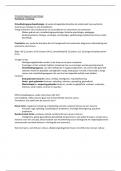Samenvatting
Summary Complete overview of all lectures notes Environmental Psychology GEO-36306
- Instelling
- Wageningen University (WUR)
This document contains all information, models, and graphs presented in the lectures of Environmental Psychology. the notes I made during the lectures are also included. If you want to pass the exam, make sure you know this information very well. Make it easier by buying this document :)
[Meer zien]







